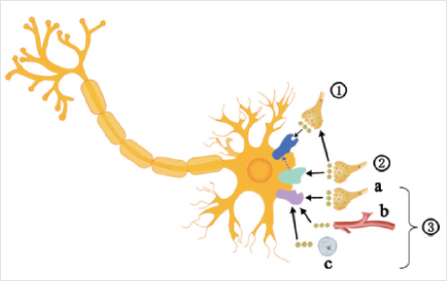Opinion
Neuronomodulation (NRM) is a proposition raised by one of us as the change in excitability state of a neuron facing the extrinsic modulatory actions of the chemical nature. Neuron lives in the extracellular fluid environment, it would face influences from chemical agents in “milieu interne” every time and everywhere. Since excitability is the most important and characteristic feature of the neuron, which is defined by the membrane polarization state, every external perturbance that could alter the polarization state of the neuron would have a modulatory effect. NRM is of great importance for the neuron functioning. According to the mode of action of modulators on the ion channel, NRM can be direct or indirect. The excitable neuron is the basis of brain function, the significance of NRM in brain function is obvious. Since NRM presents every time and everywhere for any given neuron, therefore, every act of neuronal conduction or chemical synaptic transmission can only be implemented under such conditions. NRM is as important as neuronal conduction and synaptic transmission for the implementation of neural circuit and brain function in normal and pathological conditions. In fact, we believe that NRM, together with neuronal conduction and synaptic transmission are the three underpinnings for the central nervous system functioning. It is not strange that NRM have very wide pathological and pharmacological implications in the clinic.
The idea of NRM is evolved from the modulatory action of neurotransmitters. Around 1980, the distinction between conventional synaptic action and the modulatory actions of neurotransmitter are first discussed in depth [1]. Clearly this modulatory action refers to the action of neurotransmitter acting through intracellular second messengers. In a 2016 presentation, the idea of ambient modulation of neuronal excitability was raised [2]. Ambient modulation acts by three ways:
(a) Spillover of neurotransmitters from nearby synapse
(b) Hormones from the blood stream and
(c) Paracrinal secretions (Figure 1) [2].
Conceptually, NRM covers even more broader area than ambient modulation. For direct NRM, the most outstanding case is the tonic inhibition mediated by extrasynaptic GABAa receptors [3], a relevant issue is the action of neurosteroids [4], the binding of animal venom toxins to the voltage-gated ion channels and its actions are further examples [5]. Up to present we know little of the existence of tonic excitation of the neuron. For indirect NRM, all slow potential changes implemented by metabotropic receptors, be it evoked by small molecule neurotransmitters or neuropeptides, are all typical examples. Furthermore, there are evidences that hormones, cytokines, and chemokines can act by means of indirect NRM [6-9].
Figure 1:Synaptic transmission, synaptic modulation and ambient modulation of neuronal excitability.
1. Synaptic transmission
2. Can be modulated by neuromodulators released by neighboring presynaptic terminals
3. Acting either presynaptically or postsynaptically. The ambient modulation of neuronal excitability Acts by three ways:
a) spillover of neurotransmitters from nearby synapse
b) Hormones from the blood stream
c) And paracrinal secretions. (Adapted from Chen, 2016).
The molecular target of NRM is the ion channels on neuronal membrane. The significance of allosteric modulation of receptor and non-receptor molecules should be emphasized. Much of the implementation of NRM is associated with allosterism and binding activity of non-receptor molecules. This issue has been made clearer due to the recent advancement of structural biology, especially the advent of cryoEM [10,11]. The real situation of NRM is akin to volume transmission, they may represent two sides of a coin, with the former emphasizes the information transfer between neurons and the latter emphasizes the alternation of excitability of neuron. Brain modulatory systems and neuromodulation maneuver in clinic are frequently used terms in neuroscience literature, but their foundation is relied on NRM.
Acknowledgment
Lin Xiao was supported by grants from the National Natural Science Foundation of China (31970913); Guangdong Basic and Applied Basic Research Foundation (2021A1515012156); CAS Key Laboratory of Brain Connectome and Manipulation (2019DP173024); Key-Area Research and Development Program of Guangdong Province (2019B030335001 and 2018B030332001).
References
- Kupfermann I (1979) Modulatory Actions of Neurotransmitters. AR Neurosci 2: 447-465.
- Chen YZ (2016) Ambient modulation of neuronal excitability. Acta Physiol Sin 68(4): 385-390.
- Farrant M, Nusser Z (2005) Variations on an inhibitory theme phasic and tonic activation of GABAA receptors. NR Neurosci 6(3): 215-219.
- Carver CM, Reddy DS (2013) Neurosteroid interactions with synaptic and extrasynaptic GABAa receptors. Psychopharmacology (Berl) 230(2): 151-158.
- Feng YJ, Feng Q, Tao J, Zhao R, Ji YH (2015) Allosteric interactions between receptor site 3 and 4 of NaV channels a novel perspective for the underlying mechanism of scorpion sting-induced pain. Venom Anim Toxins Incl Trop Dis 21: 42.
- Chen YZ, Hua SY, Wang CA, Wu LG, Gu Q, et al. (1991) An electrophysiological study on the membrane receptor-mediated action of glucocorticoids in mammalian neurons. Neuroendocrinol 53(1): 25-30.
- Kanageswaran N, Nagel M, Scholz P, Mohrhardt J, Gisselmann G, et al. (2016) Modulatory Effects of Sex Steroids Progesterone and Estradiol on Odorant Evoked Responses in Olfactory Receptor. PLoS One 11(8): e0159640.
- Qian J, Zhu L, Li Q, Belevych N, Chen Q, et al. (2012) Interleukin-1R3 mediates interleukin-1–induced potassium current increase through fast activation of Akt kinase. PNAS 109(30): 12189-12194.
- Hoffmann T, Sauer SK, Horch RE, Reeh PW (2008) Sensory transduction in peripheral nerve axons elicits ectopic action potentials. J Neurosci 28(24): 6281-6284.
- Changeux JP (2018) The nicotinic acetylcholine receptor a typical‘allosteric machine. Phil Trans R Soc B 373(1749): 20170174.
- Cao E (2020) Structural mechanisms of transient receptor potential ion channels. J Gen Physiol 152(3): e201811998.

 Opinion
Opinion
